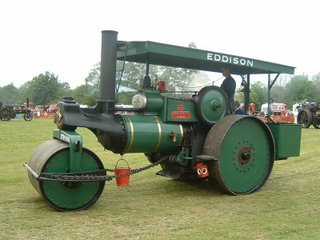It all started around AD62, in Alexandria, Hero the Mathematician was making a cup of tea when he noticed the steam spitting out the spout of his kettle. He thought this would make a great Spinning Thing if he put two spouts on the kettle in opposite directions. And it was. And, Oh! how the Alexandrian’s laughed. “Have you seen Hero’s Spinning Kettle?” they’d ask each other, chuckling in the streets of Alexandria. And he might have been remembered merely as a cheap showman had he not gone on to write a Treatise on Pneumatics and generally Sorted Out a few things. Even so, I guess someone will have commented: “Is that it, then? Doesn’t it do anything?” And it didn’t, it just spun.
It carried on doing nothing for nearly 1600 years until 1678 when Thomas Savery converted Dennis Papin’s Digester – a crude pressure cooker – into a crude steam engine, pump water from a mine. [see how important tunelling is in the scheme of things?]

Well there was no stopping things now, next up Thomas Newcomen, a blacksmith, built a more complicated engine which was far more efficient. Then came the Famous Inventor of the Steam Engine James Watt who improved on these other engines with all sorts of fiddley bits and technical stuff and his engine became Top Engine and was the main reason for the Industrial Revolution.
Back on the roads, another engine was gripping the nation – the Internal Combustion Engine and with the vastly increased speeds of transport the demands for better and smoother roads grew ever stronger. At first they used steam traction engines to pull the iron rollers, then found that the engine was doing a better job of flattening the road than the roller was. So Thomas Aveling decided to fix a giant roller instead of front wheels.

a 1937 Aveling Barford 6 nhp 10 ton Steam Roller, built to an earlier design by Ruston & Hornsby [see: a brief history of holes in the ground].
Aveling-Barford was formed in 1933, when Aveling & Porter and Barford & Perkins amalgamated. The question we need to ask, I feel, is why the new company wasn’t called Aveling-Perkins, or Porter-Barford, or indeed Porter-Perkins? Maybe Mr Perkins had been caught pinching biscuits from the biscuit tin, or maybe Mr Porter had been playing away fixtures with Mrs Aveling. Who knows, Aveling-Barford was the name on the Dinky Toy box and that’s good enough for me.

No comments:
Post a Comment